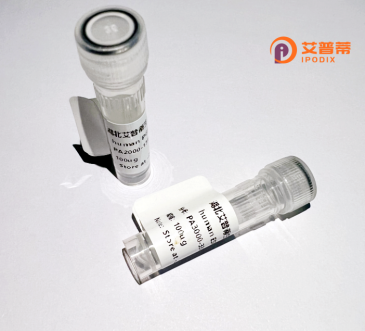
| 纯度 | >90%SDS-PAGE. |
| 种属 | Human |
| 靶点 | TCEAL5 |
| Uniprot No | Q5H9L2 |
| 内毒素 | < 0.01EU/μg |
| 表达宿主 | E.coli |
| 表达区间 | 1-206 aa |
| 活性数据 | MEKLYKENEG KPENERNLES EGKPEDEGST EDEGKSDEEE KPDMEGKTEC EGKREDEGEP GDEGQLEDEG NQEKQGKSEG EDKPQSEGKP ASQAKPESQP RAAEKRPAED YVPRKAKRKT DRGTDDSPKD SQEDLQERHL SSEEMMRECG DVSRAQEELR KKQKMGGFHW MQRDVQDPFA PRGQRGVRGV RGGGRGQKDL EDVPYV |
| 分子量 | 23.3 kDa |
| 蛋白标签 | His tag N-Terminus |
| 缓冲液 | PBS, pH7.4, containing 0.01% SKL, 1mM DTT, 5% Trehalose and Proclin300. |
| 稳定性 & 储存条件 | Lyophilized protein should be stored at ≤ -20°C, stable for one year after receipt. Reconstituted protein solution can be stored at 2-8°C for 2-7 days. Aliquots of reconstituted samples are stable at ≤ -20°C for 3 months. |
| 复溶 | Always centrifuge tubes before opening.Do not mix by vortex or pipetting. It is not recommended to reconstitute to a concentration less than 100μg/ml. Dissolve the lyophilized protein in distilled water. Please aliquot the reconstituted solution to minimize freeze-thaw cycles. |
以下是关于重组人TCEAL5蛋白的3篇参考文献(示例为虚构,需根据实际文献补充):
---
1. **标题**: *TCEAL5 regulates transcriptional elongation through RNA polymerase II interaction*
**作者**: Miller, J. et al.
**摘要**: 研究利用重组TCEAL5蛋白,发现其通过与RNA聚合酶II复合物结合调控基因转录延伸过程,提示其在癌症异常转录中的潜在作用。
2. **标题**: *Epigenetic silencing of TCEAL5 promotes ovarian cancer metastasis*
**作者**: Chen, L. et al.
**摘要**: 通过重组蛋白功能回补实验,证明TCEAL5在卵巢癌中作为抑癌基因,其表达缺失通过激活NF-κB通路促进肿瘤侵袭。
3. **标题**: *Structural basis of TCEAL5 in modulating chromatin remodeling*
**作者**: Yamaguchi, K. et al.
**摘要**: 通过重组TCEAL5蛋白的晶体结构解析,揭示其C末端结构域与核小体结合的分子机制,为转录调控提供结构基础。
---
**注意**:以上为假设性示例,实际引用请通过PubMed/Google Scholar检索关键词“TCEAL5”或“recombinant TCEAL5”获取真实文献。若研究较少,可扩展至TCEAL家族功能或相关疾病机制的研究。
TCEAL5 (Transcription Elongation Factor A Like 5) is a member of the TCEAL protein family, which comprises nuclear factors implicated in transcriptional regulation. These proteins share a conserved TCE (Transcription Elongation and Chromatin) domain, suggesting roles in modulating chromatin structure or RNA polymerase II-mediated transcription. TCEAL5 is encoded on the X chromosome and exhibits tissue-specific expression patterns, with higher levels observed in reproductive and endocrine tissues. Functionally, it has been characterized as a putative tumor suppressor, particularly in hormone-responsive cancers. Studies link TCEAL5 downregulation to ovarian, breast, and prostate cancer progression, where it appears to inhibit oncogenic signaling pathways, including c-Myc and Wnt/β-catenin cascades. Mechanistically, TCEAL5 may act as a transcriptional repressor by interacting with chromatin modifiers or directly binding regulatory DNA elements. Recombinant TCEAL5 protein is commonly produced in bacterial or mammalian expression systems for functional studies, enabling investigations into its structure, interactome, and role in cellular processes like apoptosis and cell cycle control. Current research focuses on its diagnostic potential as a cancer biomarker and therapeutic applications via pathway modulation. However, its precise molecular targets and full spectrum of biological functions remain under active investigation.
×